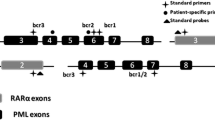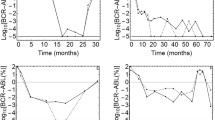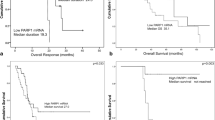Abstract
The PML/RARα fusion RNA can be detected in acute promyelocytic leukemia (APL), cytogenetically characterized by the translocation t(15; 17). Our study included ten newly diagnosed patients with APL who were investigated during the course of their diseases using reverse transcription polymerase chain reaction (RT-PCR). At diagnosis, aberrant fragments with a size heterogeneity due to alternative spliced products were detected in all patients, we observed breakpoints within bcr3 (short type) in two patients and bcr1 and 2 breakpoints (long type) in eight patients. Treatment consisted of all-trans retinoic acid (ATRA) in all patients; six patients received simultaneous cytostatic therapy during remission induction. At the time of complete hematological remission (CR), only two patients showed a negative RT-PCR result; eight of the ten patients were still PCR positive when nested primers were used. Subsequently, eight patients received consolidation chemotherapy and became PCR negative. Seven of eight patients are in continuous complete remission (median remission duration: 21 months, range: 11+−26+ months). One patient of the chemotherapy group became PCR positive after 4 months in complete remission and relapsed after 6 months. The remaining two patients who were treated only with ATRA relapsed, received induction chemotherapy, and are in second and third complete remission, respectively. In conclusion, PCR negativity can be achieved only by chemotherapeutic consolidation; patients treated with ATRA alone remain PCR positive. Relapse is always preceded by a positive PCR result. Surprisingly, also patients without measurable PML/ RARα-mRNA in sequential analyses after cytostatic treatment became PCR positive and experienced relapse.
Similar content being viewed by others
References
Pandolfi PP, Alcalay M, Fagioli M, Zangrilli D, Mencarelli, Diverio D, Biondi A, Lo Coco F, Rambaldi A, Grignani F, Rochette-Egly C, Gaube M-P, Chambon P, Pelicci PG (1992) Genomic variability and alternative splicing generate multiple PML/RARα transcripts that encode aberrant PML proteins and PML/RARα isoforms in acute promyelocytic leukemia. EMBO J 11:1397–407
Chomienne C, Ballerini P, Balitrand N, Daniel MT, Fenaux P, Castaigne S, Degos L (1990) All-trans retinoic acid in acute promyelocytic leukemias. II. In vitro studies: structure-function relationship. Blood 76:1710–1717
Huang ME, Ye YC, Chen SR, Chai JR, Lu JX, Zhoa L, Gu LJ, Wang ZY (1988) Use of all-trans retinoic acid in the treatment of acute promyelocytic leukemia. Blood 72:567–572
Castaigne S, Chomienne C, Daniel MT, Ballerini P, Berger R, Fenaux P, Degos L (1990) All-trans retinoic acid as a differentiation therapy for acute promyelocytic leukemia. I. Clinical results. Blood 76:1704–1709
Koller E, Krieger O, Reisner R, Grill R, Waldner R, Lutz D (1992) All-trans retinoic acid in primary and relapsed acute promyelocytic leukemia. Onkologie 15:42–45
Fenaux P, Le Deley MC, Castaigne S, Archimbaud E, Link H, Guerci A, Duarte M, Daniel MT, Bowen D, Huebner G, Bauters F, Fegueux N, Fey M, Sanz M, Lowenberg B, Maloisel F, Auzanneau G, Sadoun A, Gardin C, Bastion Y, Ganser A, Jacky E, Dombret H, Chastang C, Degos L, and the European APL91 Group (1993) Effect of all-transretinoic acid in newly diagnosed acute promyelocytic leukemia. Results of a randomized trial. Blood 82:3241–3249
Biondi A, Rambaldi A, Pandolfi PP, Rossi V, Guidici G, Alcalay M, Lo Coco F, Diverio D, Pogliani EM, Lanzi EM, Mandelli F, Masera G, Barbui T, Pelicci PG (1992) Molecular monitoring of the myl/retinoic acid receptor-α fusion gene in acute promyelocytic leukemia by polymerase chain reaction. Blood 80:492–497
Huang W, Sun GL, Li XS, Cao Q, Lu Y, Jang GS, Zhang FQ, Chai JR, Wang ZY, Waxman S, Chen Z, Chen SJ (1993) Acute promyelocytic leukemia: clinical relevance of two major PML-RARα isoforms and detection of minimal residual disease by retrotranscriptase/-polymerase chain reaction to predict relapse. Blood 82:1264–1269
Lo Coco F, Diverio D, Pandolfi PP, Biondi A, Rossi V, Avvisati G, Rambaldi A, Arcese W, Petti MC, Meloni G, Mandelli F, Grignani F, Masera G, Barbui T, Pelicci PG (1992) Molecular evaluation of residual disease as a predictor of relapse in acute promyelocytic leukemia. Lancet 340:1437–1438
Miller WH Jr, Levine K, DeBlasio A, Frankel S, Dmitrovsky E, Warrel RP Jr (1993) Detection of minimal residual disease in acute promyelocytic leukemia by a reverse transcription polymerase chain reaction assay for the PML/RARα fusion mRNA. Blood 82:1689–1694
Grignani F, Fagioli M, Alcalay M, Longo L, Pandolfi PP, Donti E, Biondi A, Lo Coco F, Grignani F, Pelicci PG (1994) Acute promyelocytic leukemia: from genetics to treatment. Blood 83:10–25
Author information
Authors and Affiliations
Rights and permissions
About this article
Cite this article
Koller, E., Karlic, H., Krieger, O. et al. Early detection of minimal residual disease by reverse transcriptase polymerase chain reaction predicts relapse in acute promyelocytic leukemia. Ann Hematol 70, 75–78 (1995). https://doi.org/10.1007/BF01834383
Received:
Accepted:
Issue Date:
DOI: https://doi.org/10.1007/BF01834383




